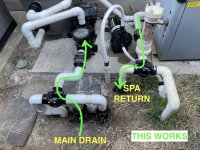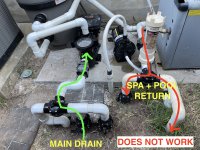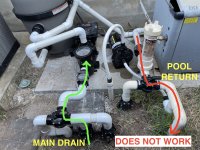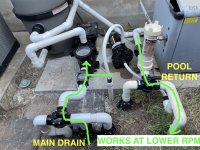Hi folks. Just had a local pro install some new equipment (pump, filter, booster) and in the process he re-did my suction side plumbing. New equipment is working well, but in the process he changed the configuration of the suction side plumbing and I have questions about it.
Here is what I started with, i.e. before equipment install. This setup worked OK, except the system is a pain to prime if the pump shuts off because this equipment is uphill from my pool/spa.
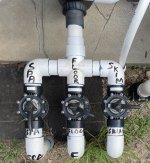
And here is what I have now after the equipment install:
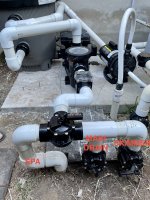
The two main changes are:
* Addition of a check valve before pump, helps with subsequent re-priming.
* Now only one Jandy valve needs to be moved to switch between pool and spa mode (simplify future automation...), whereas before I potentially had to move 3 valves to do the switch.
Now, my questions:
1. Does this look like an OK installation? I'm no fluid dynamics expert, but I observe there are many more 90-degree bends than there were before, and I know this can't be good for flow. But maybe this is not unusual for this type of equipment? Can someone give me an objective assessment of this setup?
2. I'm getting major cavitation if I try to pull from main drain only (I.e. spa and skimmer suction off). I can pull from the main drain successfully only if the skimmer line is also open. I can't help but think this is related to #1. In my original setup on the main drain line there was only a single 90 degree bend from the ground to the pump. Now there are four, one of which is a "T" fitting.
Installer is coming out tomorrow to take care of some unrelated leaks downstream of the pump, and I've already mentioned the cavitation issue and plan to discuss tomorrow, but I'd like to get some opinions about this before that chat.
Chris
Here is what I started with, i.e. before equipment install. This setup worked OK, except the system is a pain to prime if the pump shuts off because this equipment is uphill from my pool/spa.

And here is what I have now after the equipment install:

The two main changes are:
* Addition of a check valve before pump, helps with subsequent re-priming.
* Now only one Jandy valve needs to be moved to switch between pool and spa mode (simplify future automation...), whereas before I potentially had to move 3 valves to do the switch.
Now, my questions:
1. Does this look like an OK installation? I'm no fluid dynamics expert, but I observe there are many more 90-degree bends than there were before, and I know this can't be good for flow. But maybe this is not unusual for this type of equipment? Can someone give me an objective assessment of this setup?
2. I'm getting major cavitation if I try to pull from main drain only (I.e. spa and skimmer suction off). I can pull from the main drain successfully only if the skimmer line is also open. I can't help but think this is related to #1. In my original setup on the main drain line there was only a single 90 degree bend from the ground to the pump. Now there are four, one of which is a "T" fitting.
Installer is coming out tomorrow to take care of some unrelated leaks downstream of the pump, and I've already mentioned the cavitation issue and plan to discuss tomorrow, but I'd like to get some opinions about this before that chat.
Chris


